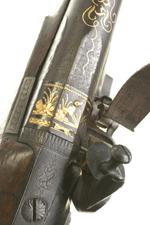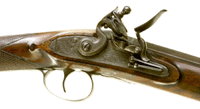|
Cowan's
Corner
Flintlock Fowler Firearms
Fuel Collecting Frenzy
By Wes Cowan
Used for both hunting and defense in early 18th century America, the
flintlock fowler was the first gun crafted in this country. Flintlock is the
general term for any firearm based on the flintlock mechanism. The type is now
obsolete. Introduced about 1630, it rapidly replaced earlier technologies (such
as the matchlock and wheelock) and continued to be in common use for more than
two centuries, replaced by cap and cartridge-based systems in the early-to-mid
19th century.
|

|
A Rich Hollis English flintlock fowler, ca. 1840, sold for $1,840 in May
2006.
|
The flintlock fowler had a light butt that fit well onto the
shooter's shoulder and cheek, greatly increasing the accuracy of his or her aim.
Shooting from horseback using fowlers was great sport among the European
nobility dating back to the mid-16th century when it replaced hawking, the
earliest sporting tradition for hunting birds.
In 1671, English Parliament
prohibited the killing of game, even on one's own land, except for qualified
persons, such as those of nobility, people of high social status, and large land
owners. It wasn't until after the French Revolution that the common people
regained their gaming rights, and shooting became a recognized sport for the
masses. As a result, fowling pieces were manufactured on a large scale, and the
nobility took up fox hunting as a replacement sport.
Some ornate fowlers
include silver wire inlay in the stock forming intricate scrolling. Others
display floral ornamentation or hunting scenes. The wood is often heavily carved
and checkered with ornate metal hunting motifs applied. French, Italian and
German firearms were generally more decorative than the British Flintlock
Fowler. Due to limited facilities and know-how, American flintlock fowling
pieces manufactured during the colonial era were less skillfully engraved and
carved than their European counterparts.
In spite of its benefits compared
to other firearms, the flintlock fowler had some inherent problems. Reloading
the powder in damp weather, for example, caused misfires and blown barrels.
American Revolutionary War hero and the first Secretary of War Henry Knox lost
the third and fourth fingers on his left hand when the barrel of his fowling
piece exploded. It was 1773, and he was gunning in east Boston on Noddle's
Island.
The problem posed by the misfiring of muzzle loading guns was
largely overcome by the invention of the percussion cap. The Reverend Alexander
John Forsyth of Scotland was an ardent hunter of wildfowl in waters. In 1807, he
invented and patented a percussion ignition for a gun. By 1830, percussions had
almost entirely taken the place of flintlocks, thus bringing to an end the era
of the flintlock fowler.
Tips for Collecting Flintlock Fowlers. Flintlock firearms have greater value
when they retain all original parts. Collectors should be wary of
re-conversioned guns: flintlock converted to percussion and then back to
flintlock. Springs, screws and other parts should be carefully inspected to make
sure that they are original to the gun.
Check condition carefully. A firearm
that has been properly cared for over the years should have no oxidation and
little or no pitting in the metal surfaces. The wooden stock should retain its
original varnish and should not be dried and weathered. Always closely examine
for cracks in the wood as repairs of any kind diminish value.
Be sure to
research on the maker of the firearm by consulting books or web sites on early
sporting firearms. Some flintlock fowler manufacturers, such as Joseph Manton
and Henry Nock, command higher prices than others.
 About the author: Wes Cowan is founder and owner of Cowan's Auctions, Inc. in Cincinnati, Ohio. An
internationally recognized expert in historic Americana, Wes stars in the PBS television
series History Detectives and is a featured appraiser on Antiques Roadshow. He can be
reached via email at info@historicamericana.com. Article research by Joe Moran. About the author: Wes Cowan is founder and owner of Cowan's Auctions, Inc. in Cincinnati, Ohio. An
internationally recognized expert in historic Americana, Wes stars in the PBS television
series History Detectives and is a featured appraiser on Antiques Roadshow. He can be
reached via email at info@historicamericana.com. Article research by Joe Moran.

|

Detail of intricate gold filigree
on top of barrel and breech regions,
custom-made per an owner's request.

Detail of flintlock mechanism
of a Williams English flintlock fowler. Note
the intricate engravings on lock plate, and the checkered wood wrist; sold for
$1,265.
|